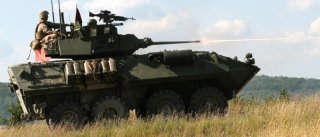Could This Become the Army’s New Light Tank?
The United States Army’s Mobile Protected Firepower program, which seeks to field a light tank, is set to enter a limited user testing phase of evaluation.
The Mobile Protected Firepower Program winner could provide the U.S. Army with a lightweight, air-mobile armored vehicle.
The United States Army’s Mobile Protected Firepower program, which seeks to field a light tank, is set to enter a limited user testing phase of evaluation, per Jane’s. The tests reportedly involve input from Army tankers for improving the two prototypes vehicle designs.
Mobile Protected Firepower
The U.S. Army’s Mobile Protected Firepower (MPF) program addresses a capabilities gap for the Army’s Infantry Brigade Combat Teams. IBCTs “do not have a combat vehicle assigned that is capable of providing mobile, protected, direct, offensive fire capability… against hardened positions, dismounted personnel and light armored vehicles,” an article published by the Army explains.
Notably, the Mobile Protected Firepower vehicle, essentially a light tank, won’t go to the Army’s heavy armor brigades, which already have an effective armor platform and organic armor support infrastructure. Instead, the MPF will equip light infantry and airborne units within the Army that do not have a tracked armored vehicle.
Ideally, the MPF vehicle will bridge the gap between adequate armor protection and weight to be air-mobile. This will be far from easy. The last airborne-capable tracked armored vehicle in Army service was the problematic M551 Sheridan. Other light tanks like the M41 Walker Bulldog proved too heavy for air mobility.
General Dynamics
The vehicle General Dynamics built for MPF has the advantage of leveraging the GD’s extensive, decades-long tank-building experience (GD also makes the M1 Abrams main battle tank). In addition, electronics and fire controls are expected to be similar to the larger M1, simplifying training.
Their bid incorporates some components from the company’s Ajax vehicle supplied to the British Army. That vehicle has been particularly problematic — several British tankers required medical assistance after excessive vibration and noise caused hearing loss and minor injuries. It is unclear if this will also be an issue for the GD’s MPF.
Though GD’s prototype sports a 105mm main gun (most NATO main battle tank’s guns are 120mm in diameter), the vehicle is far from small, and earlier prototype weights have ranged from under thirty to fifty tons, raising questions about the vehicle’s mobility via air transport and on land under its own power.
BAE Systems
On the other hand, BAE’s vehicle is considerably smaller and lighter, a selling point the company has highlighted. In addition, unlike many armored vehicles, their prototype’s engine is easily removable for in-the-field repairs or maintenance.
BAE leverages an older design in their vehicle portfolio, the M8 Armored Gun System, a failed bid to replace the Sheridan as the Army’s air-mobile light tank. The modernized design improves underbelly blast protection and updated electronics and engine, but the vehicle’s relatively modest engine output could be a limiting factor despite its low base weight.
Postscript
Both vehicles have strengths and weaknesses, neither has a clear advantage over the other. However, following soldier assessments, one of the two should come out on top.
Caleb Larson is a multimedia journalist and Defense Writer with The National Interest. He lives in Berlin and covers the intersection of conflict, security, and technology, focusing on American foreign policy, European security, and German society.
Image: Flickr

